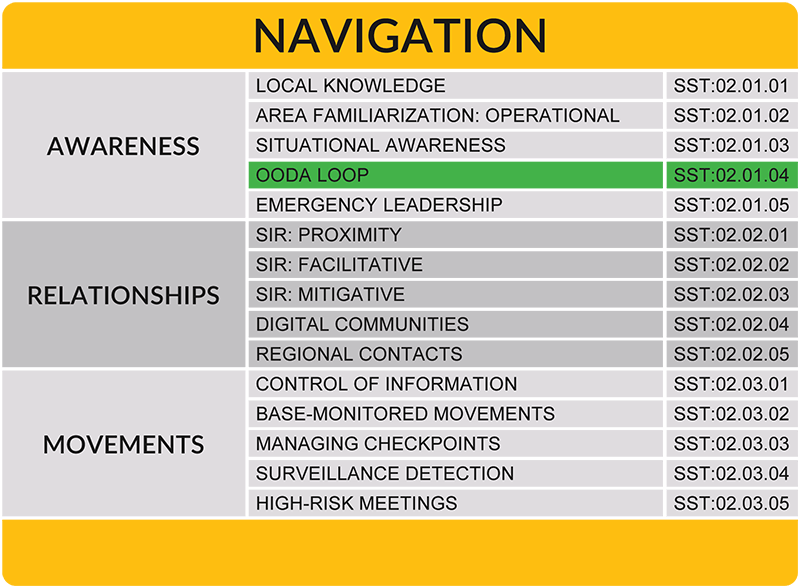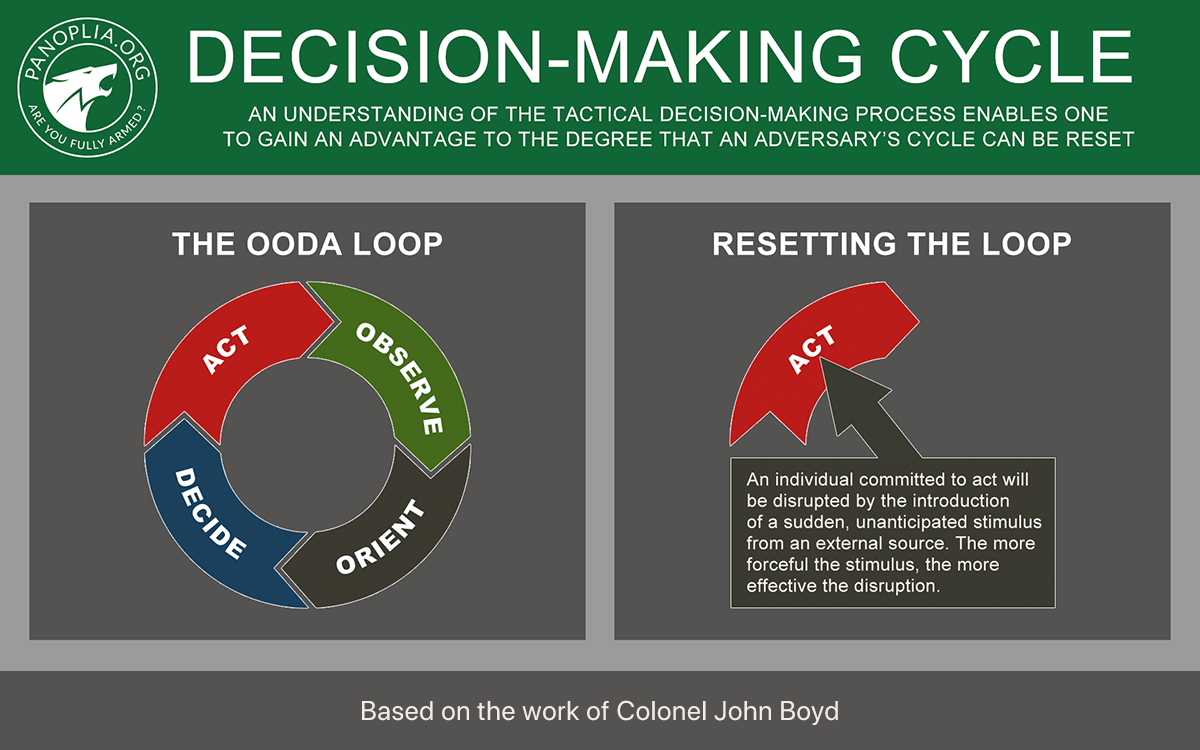We participate in a number of in-person SST courses each year. Although it would be great if these were open to the public, at this point they are for individuals heading out to serve in challenging international locations.
Each training event has its own group of participants, and each group has its own personality. Our most recent in-person SST training course had an awesome group. They were young, enthusiastic, and asked some very good questions.
One of the questions asked related to the second “O” in John Boyd’s OODA Loop. As you likely know, the OODA Loop is an acronym that stands for Observe, Orient, Decide, and Act. Apparently originally developed for air-to-air combat pilots, the OODA Loop has been adapted and applied to numerous other fields. These range from tactical ground engagements, to close-quarter self-defense, and even to business strategies.
For tactical training, the focus is generally on how resetting an adversary’s loop can offer one a tactical advantage in an engagement. This is described in the image at the top of this page. During training, many seem to grasp the basics involved in observation, decision-making, and acting pretty well. In our online SST course and during in-person training we describe how observation involves more than one might think at first glance. Even so, the decision and action steps are generally well understood.
The step that often trips people up, and that was the subject of a great question by members of the Group that attended the most recent in-person SST training, was in regard to orientation. We thought it might be worth sharing here some of how we answered this question.
We suggested that one way to look at the “Orient” step was to think of the word “context.” In other words, when something is observed that may be a threat, before deciding on an action step it’s important to place what’s happening into its proper context. Here’s an example.
One may “observe” that shots are fired, some on full-auto, into the air from AK-47s during a wedding. In the context of a wedding taking place in the West, this would be unusual, unexpected, and problematic. It would likely cause a trained individual to “decide” on a tactical response and to “act” very quickly. And yet, if the same situation took place in certain rural, mountainous portions of Central Asia, this would represent normative behavior for men celebrating the marriage. It’s simply a way to show one’s approval and enthusiasm for what’s taking place. For those who understand the context, no “decision” or “action” is necessary other than to applaud and enjoy the celebration.
This illustrates the importance of how context matters in the second “O” of the OODA Loop. Here’s an example from closer to home, and that might be experienced on a more regular basis.
As described in articles we posted in May 2021 and January 2022, we’ve set up some simple, affordable, and very dependable perimeter alarms around our property. These emit distinctive sounds depending on the direction from which a person is approaching our home. We keep the sound level quite low, yet we can hear the signal clearly both day and night.
In this day and age it’s becoming less common than it once was for individuals such as door-to-door salespeople to arrive unexpected on one’s doorstep. This being the case, we’ve become accustomed to the normal times when our perimeter alarms sound off. These include when we invite a couple over for dinner, when either my wife or I go out to sweep the front or back porch, etc.
One of the less-expected times we hear the perimeter alarms sound off are when Amazon, Fed-Ex, or UPS drivers drop off a package. Even though we may not know exactly when they are coming, we can usually tell that a certain alarm has been tripped by a delivery person in two ways. First, such deliveries generally take place in the late afternoon. Second, the way the alarm sounds for deliveries is that it rings once for when the driver approaches the front door, and again in three seconds or so for when he or she heads back to the truck. Between the time of day and the quick succession of sounds, we can generally tell what’s happening when we “observe” our perimeter alarm going off in this way, and no “decision” or “action” is necessary.
Yet, if the same perimeter alarm sequence took place at 3:45AM, this would be very unusual, and you can be sure that after “observing” through sound that someone was approaching our home at this hour, a quick “decision” would be made, and “action” would rapidly follow. This would probably involve me grabbing a firearm, a flashlight, and checking on what’s happening in the direction indicated by the perimeter alarm. In fact, this has happened a few times when a racoon decided at 3:00AM or so to climb the tree in our front yard that has a perimeter alarm facing our home on it.
You can see how in the second example “context” in relation to the time of day would result in very different “decisions” being made and “actions” taking place. In the first case the quick “orientation” to the alarm would either be ignored, or might cause one of us to casually glance outside, whereas the second situation would wake us up and would necessitate a very different response.
For more information on the OODA Loop, and especially on the second “O” in the sequence, please see Part Two, Section 02.01.04 of the Panoplia.org online Soft Skills and Tactics (SST) training course.





0 Comments